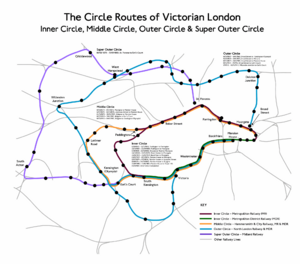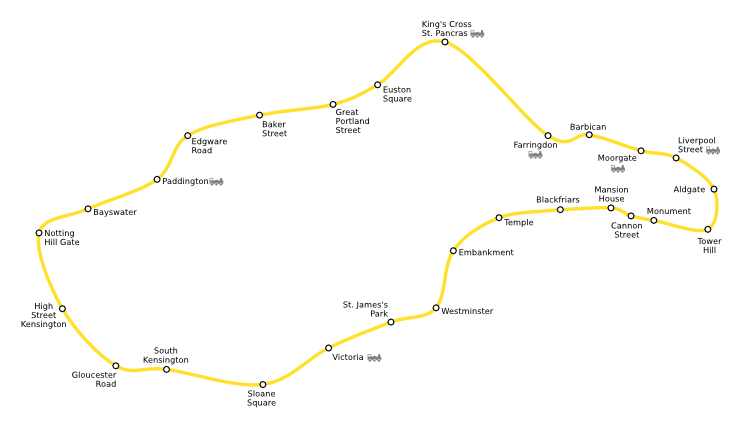Circle Line
| Circle | |||||||||||||||||||||||||||||||||||
|---|---|---|---|---|---|---|---|---|---|---|---|---|---|---|---|---|---|---|---|---|---|---|---|---|---|---|---|---|---|---|---|---|---|---|---|
| Colour on map | Yellow | ||||||||||||||||||||||||||||||||||
| Year opened | 1884 | ||||||||||||||||||||||||||||||||||
| Line type | Sub-Surface | ||||||||||||||||||||||||||||||||||
| Rolling stock | C Stock | ||||||||||||||||||||||||||||||||||
| Stations served | 27 | ||||||||||||||||||||||||||||||||||
| Length (km) | 22.5 | ||||||||||||||||||||||||||||||||||
| Length (miles) | 14 | ||||||||||||||||||||||||||||||||||
| Depots | Hammersmith Neasden | ||||||||||||||||||||||||||||||||||
| Journeys made | 68,485,000 (per annum) | ||||||||||||||||||||||||||||||||||
| Rail lines of Transport for London | |||||||||||||||||||||||||||||||||||
| |||||||||||||||||||||||||||||||||||
The Circle Line of the London Underground became known as such in 1949, when it was designated separately from its parent lines, the Metropolitan Line and the District Line, although it had been shown on Underground maps since 1947. It can be thought of as a "virtual line", as the Circle Line does not have any stations for its sole use. This is because the Circle Line was created from two previously-existing lines (see history below). The only two sections of track over which the Circle Line operates exclusively are the chords between High Street Kensington and Gloucester Road, and between Tower Hill and Aldgate. The line has interchanges with most of the major London terminals.
As the name implies, trains on the line run a continuous circuit. A complete journey around the line would take 45 minutes, but time-tabling constraints mean that each train has a scheduled two-minute stop at High Street Kensington and Aldgate, extending the time required for a full circuit to 49 minutes. This allows the service to operate with seven trains in each direction with a seven-minute service interval. It has 27 stations and 14 miles (22.5 km) of track. There are usually quicker routes on other lines when travelling from south to north or vice versa. In the north, east and west of central London, the Circle Line approximately outlines Travelcard Zone 1, but in the south there is a substantial portion of the zone outside the Circle Line. It and the two-stop Waterloo & City Line are the only lines completely within Zone 1.
Contents
History
- see main article Metropolitan and Metropolitan District Railways
The route now known as the Circle Line was authorised when Acts of Parliament in 1853 and 1854 empowered the Metropolitan Railway (MR) and the Metropolitan District Railway (MDR) to construct the world's first underground railway in central London. From an initial section between Farringdon and Paddington stations, the route was gradually extended at each end. Financial difficulties in the construction of the section through the City of London as well was animosity between the two railway companies delayed completion of the full circuit until 6 October 1884, although it had been known as the Inner Circle since the 1870s.
Trains on the route were originally hauled by steam engines, but electrification was started with an experimental section in 1900. A disagreement between the two companies over the method of electrification delayed the exercise, so that the first electric trains were introduced gradually over the 11 days to 24 September 1905.
Other Circle Routes
The success of the Inner Circle lead to the operation of a number of other circular routes within the capital, over existing main line routes and sections of the MR's and MDR's Inner Circle tracks:
- Middle Circle - Aldgate to Mansion House via Addison Road (now Kensington (Olympia))
- Outer Circle - Broad Street to Mansion House via Willesden Junction
- Super Outer Circle - St. Pancras to Earl's Court via Cricklewood and South Acton
These routes failed to attract the passenger numbers hoped for and were eventually cut-back or ended - other services on the lines continued. Today parts of the Outer Circle and Super Outer Circle routes are operated by Silverlink trains on the North London Line. Plans to complete an outer rail loop have been relaunched under the name Orbirail [1].
7 July 2005 terrorist attack
On 7 July 2005, two Circle Line trains were bombed. The blasts occurred almost simultaneously at 08:50 BST, one between Liverpool Street and Aldgate and the other on a train at Edgware Road, damaging that train, and causing a tunnel to collapse on another train passing through the station.
Following the attacks, the whole of the Circle Line was closed. While most other lines re-opened on 8 July, the Circle remained closed for several weeks, reopening a little less than a month after the attacks, on 4 August. At least 14 people were killed by the blasts in the Circle. A third attack occurred on the Piccadilly Line between King's Cross St Pancras and Russell Square.
See 7 July 2005 London Bombings for more information
Trains
All Circle line trains are in the distinctive London Underground livery of red, white and blue and are the larger size of the two sizes used on the network.
Future
The Circle Line could cease to exist in its current form in 2011 and be merged with the Hammersmith & City Line to form a spiral route. The new route would run from Hammersmith to Paddington and then do a complete loop of the current Circle Line, terminating at Edgware Road.
Orbital routes have an intrinsic timetabling robustness problem. The trains are constantly "in orbit" so there is little scope for "recovery time" if they are delayed. A single delay can have long lasting knock on effects and be much more disruptive than on a non-orbital railway. Recovery time can be created by timetabling for longer stops at some stations but this increases journey times and reduces train frequency. The proposed spiral route would remove this problem because there would be adequate recovery time at both ends of the route.
Map
Stations
in order, clockwise from Paddington
- Paddington, for Great Western Main Line
- Edgware Road
- Baker Street
- Great Portland Street
- Euston Square, for Euston station and West Coast Main Line
- King's Cross St Pancras for Midland Main Line and East Coast Main Line
- Farringdon
- Barbican
- Moorgate
- Liverpool Street for Great Eastern Main Line
- Aldgate
- Tower Hill
- Monument
- Cannon Street
- Mansion House
- Blackfriars
- Temple
- Embankment
- Westminster

- St. James's Park
- Victoria
- Sloane Square
- South Kensington
- Gloucester Road
- High Street Kensington
- Notting Hill Gate
- Bayswater
Trivia
- The Circle Line Pub Crawl aims to visit each Circle Line station in turn, drinking a half pint or shot in a pub near to each. This is a popular event on the Saturday closest to Waitangi Day.
- There were, in 2004, three occurrences of a Circle Line Party. These were promoted by grassroots organisations such as the Space Hijackers, and involve the "hijacking" of a Circle Line train.
- Composer Robert Steadman wrote an experimental composition titled Mind the Gap for cello and orchestra, which depicts a journey around the Circle Line of the London Underground, beginning and ending with the performers shouting "Mind the gap!"
- Because trains are constantly running in the same direction around the line, the wear on the wheels becomes uneven. To prevent this, six trains per day travel from Tower Hill to Liverpool Street via Whitechapel and Aldgate East, instead of via Aldgate. This turns the train round.
- The Circle Line is mentioned in the Siouxsie and the Banshees song "Circle" from their 1982 album A Kiss in the Dreamhouse.
- The Cast Off knitting club sometimes holds knit-ins on the Circle Line [2]
External links
- Circle Line - London Underground website
- Subsurface network (SSL) upgrade - Information about planned changes to the route.
- Proposals for the Upgrade of the Sub-surface Lines.
- The Circle Line Pub Crawl website
de:Circle Line es:Circle Line fr:Circle Line it:Circle Line nl:Circle Line ja:サークル線 no:Circle-linjen sk:Circle Line


